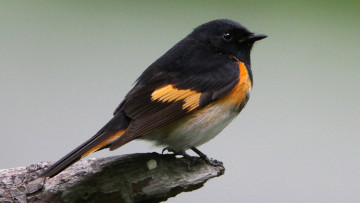Village News

PHOTO COURTESY OF GARRY KESSLER
American redstart male. Females and first-year males are gray with yellow, instead of red-orange, on their breast, wings, and tail.
May 28, 2021, Page 7A
NATURE NOTES
By Annie Reid
Westborough Community Land Trust
Redstarts are one of our warblers
Once again, it's warbler month – the merry month of May – when small colorful warblers pass through our area on their way to breed in insect-filled environments farther north. Yet some, such as American redstarts, are "our" warblers because they stay to nest and breed.
American redstarts (Setophaga ruticilla) are named for their red tails, with "start" as an old word for "tail," but males and females are colored differently. Males are jet black with red-orange patches on their breast, wings, and tail. Females have a similar pattern but are gray with yellow patches. Some confusion is possible, though, because first-year males are also gray and yellow, like females. These young males are mature and ready to breed, but they won’t get their mature black and red-orange colors until their second year.
Redstarts make good use of their colors. Both males and females often fan their tails and flash their colorful wing patches as they hop and flit about branches and twigs, hunting insects. This behavior can startle their insect prey into moving – and getting captured. If you catch a glimpse of this behavior, it's a clue that you might be watching a redstart.
Fanning and flashing also come in handy when rivals – typically male – face off near the boundary of a territory. And of course, showing off their colors by fanning and flashing can be part of attracting a mate. When it comes to reproduction, the most intensely colored males tend to be the most successful. A few males might even set up two territories and have two mates and families. Yet the gray first-year males are less lucky and more likely to go without a mate.
Where might you find redstarts? Look for trees with vines near water. Trails along wooded, shrubby edges of ponds or wetlands are promising. These days it’s not hard to find tall trees covered with Asian bittersweet vines, poison ivy vines, or grapevines. Redstarts forage for insects at low as well as high levels, so they can be easier to see than many other warblers. They also usually nest below 15 feet.
Redstart males announce themselves by song. They're not the only birds you might hear singing near a vine-covered tree, but they sing energetically and usually continue to sing as long as they're here. They sing two types of song, consisting of 2-11 high-pitched notes. One type has a slurred ending, and the other is plain. (Listen at https://www.allaboutbirds.org/guide/American_Redstart/sounds.)
Our redstarts are with us about two months, just long enough to raise a family. They take up to a week to build a nest, up to about two weeks to incubate 3-4 eggs, and up to about two weeks for chicks to mature enough to leave the nest. Then parents still feed them for up to three weeks. But by mid-July they'll probably be gone. Redstarts winter in the Caribbean, Mexico, central America, and northern South America. They can be found among mangroves and on shade-grown coffee plantations.
Enjoy looking and listening for redstarts while they're here. Remember that they are forest birds, and we’re fortunate to have the second-growth forests that they like, as well as numerous ponds and swamps. But things can change. As development leads to increasingly fragmented forests in our area, we risk losing habitats that they favor.